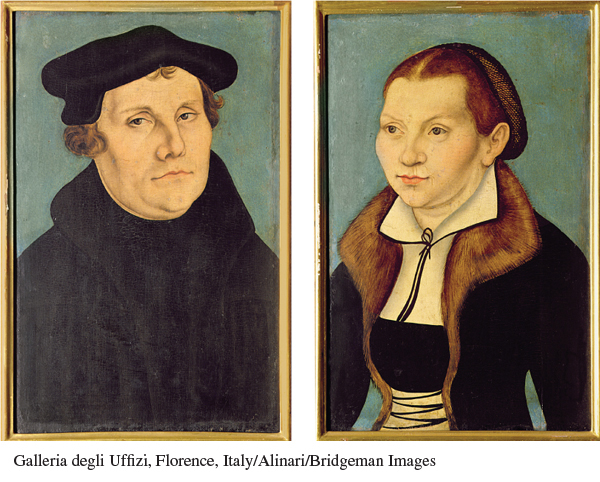A History of Western Society: Printed Page 402
A History of Western Society, Value Edition: Printed Page 383
A History of Western Society, Concise Edition: Printed Page 401
Marriage, Sexuality, and the Role of Women
Luther and Zwingli both believed that a priest’s or nun’s vows of celibacy went against human nature and God’s commandments, and that marriage brought spiritual advantages and so was the ideal state for nearly all human beings. Luther married a former nun, Katharina von Bora (1499–1532), and Zwingli married a Zurich widow, Anna Reinhart (1491–1538). Both women quickly had several children. Most other Protestant reformers also married, and their wives had to create a new and respectable role for themselves — pastor’s wife — to overcome being viewed as simply a new type of priest’s concubine. They were living demonstrations of their husband’s convictions about the superiority of marriage to celibacy, and they were expected to be models of wifely obedience and Christian charity.

Though they denied that marriage was a sacrament, Protestant reformers stressed that it had been ordained by God when he presented Eve to Adam, served as a “remedy” for the unavoidable sin of lust, provided a site for the pious rearing of the next generation of God-
Protestants did not break with medieval scholastic theologians in their idea that women were to be subject to men. Women were advised to be cheerful rather than grudging in their obedience, for in doing so they demonstrated their willingness to follow God’s plan. Men were urged to treat their wives kindly and considerately, but also to enforce their authority, through physical coercion if necessary. European marriage manuals used the metaphor of breaking a horse for teaching a wife obedience, though laws did set limits on the husband’s power to do so.
Protestants saw marriage as a contract in which each partner promised the other support, companionship, and the sharing of mutual goods. Because, in Protestant eyes, marriage was created by God as a remedy for human weakness, marriages in which spouses did not comfort or support one another physically, materially, or emotionally endangered their own souls and the surrounding community. The only solution might be divorce and remarriage, which most Protestants came to allow. Protestant allowance of divorce differed markedly from Catholic doctrine, which viewed marriage as a sacramental union that, if validly entered into, could not be dissolved (Catholic canon law allowed only separation with no remarriage). Although permitting divorce was a dramatic legal change, it did not have a dramatic impact on newly Protestant areas. Because marriage was the cornerstone of society socially and economically, divorce was a desperate last resort. In many Protestant jurisdictions the annual divorce rate hovered around 0.02 to 0.06 per thousand people. (By contrast, in 2010 the U.S. divorce rate was 3.6 per thousand people.)
As Protestants believed marriage was the only proper remedy for lust, they uniformly condemned prostitution. The licensed brothels that were a common feature of late medieval urban life (see Chapter 11) were closed in Protestant cities, and harsh punishments were set for prostitution. Many Catholic cities soon closed their brothels as well, although Italian cities favored stricter regulations rather than closure. Selling sex was couched in moral rather than economic terms, as simply one type of “whoredom,” a term that also included premarital sex, adultery, and other unacceptable sexual activities. “Whore” was also a term that reformers used for their theological opponents; Protestants compared the pope to the biblical whore of Babylon, a symbol of the end of the world, while Catholics called Luther’s wife a whore because she had first been married to Christ as a nun before her marriage to Luther. Closing brothels did not end the exchange of sex for money, of course, but simply reshaped it. Smaller illegal brothels were established, or women selling sex moved to areas right outside city walls.
The Protestant Reformation clearly had a positive impact on marriage, but its impact on women was more mixed. Many nuns were in convents not out of a strong sense of religious calling, but because their parents placed them there. Convents nevertheless provided women of the upper classes with an opportunity to use their literary, artistic, medical, or administrative talents if they could not or would not marry. The Reformation generally brought the closing of monasteries and convents, and marriage became virtually the only occupation for upper-
A few women took Luther’s idea about the priesthood of all believers to heart and wrote religious works. Argula von Grumbach, a German noblewoman, supported Protestant ideas in print, asserting, “I am not unfamiliar with Paul’s words that women should be silent in church but when I see that no man will or can speak, I am driven by the word of God when he said, he who confesses me on earth, him will I confess, and he who denies me, him will I deny.”4 No sixteenth-